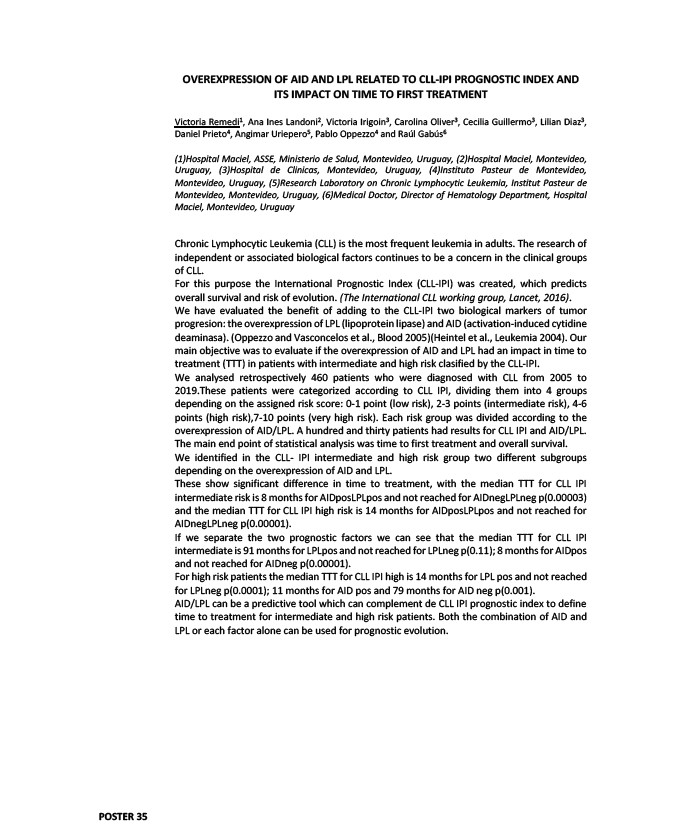
OVEREXPRESSION OF AID AND LPL RELATED TO CLL-IPI PROGNOSTIC INDEX AND
ITS IMPACT ON TIME TO FIRST TREATMENT
Victoria Remedi1, Ana Ines Landoni2, Victoria Irigoin3, Carolina Oliver3, Cecilia Guillermo3, Lilian Diaz3,
Daniel Prieto4, Angimar Uriepero5, Pablo Oppezzo4 and Raúl Gabús6
(1)Hospital Maciel, ASSE, Ministerio de Salud, Montevideo, Uruguay, (2)Hospital Maciel, Montevideo,
Uruguay, (3)Hospital de Clinicas, Montevideo, Uruguay, (4)Instituto Pasteur de Montevideo,
Montevideo, Uruguay, (5)Research Laboratory on Chronic Lymphocytic Leukemia, Institut Pasteur de
Montevideo, Montevideo, Uruguay, (6)Medical Doctor, Director of Hematology Department, Hospital
Maciel, Montevideo, Uruguay
Chronic Lymphocytic Leukemia (CLL) is the most frequent leukemia in adults. The research of
independent or associated biological factors continues to be a concern in the clinical groups
of CLL.
For this purpose the International Prognostic Index (CLL-IPI) was created, which predicts
overall survival and risk of evolution. (The International CLL working group, Lancet, 2016).
We have evaluated the benefit of adding to the CLL-IPI two biological markers of tumor
progresion: the overexpression of LPL (lipoprotein lipase) and AID (activation-induced cytidine
deaminasa). (Oppezzo and Vasconcelos et al., Blood 2005)(Heintel et al., Leukemia 2004). Our
main objective was to evaluate if the overexpression of AID and LPL had an impact in time to
treatment (TTT) in patients with intermediate and high risk clasified by the CLL-IPI.
We analysed retrospectively 460 patients who were diagnosed with CLL from 2005 to
2019.These patients were categorized according to CLL IPI, dividing them into 4 groups
depending on the assigned risk score: 0-1 point (low risk), 2-3 points (intermediate risk), 4-6
points (high risk),7-10 points (very high risk). Each risk group was divided according to the
overexpression of AID/LPL. A hundred and thirty patients had results for CLL IPI and AID/LPL.
The main end point of statistical analysis was time to first treatment and overall survival.
We identified in the CLL- IPI intermediate and high risk group two different subgroups
depending on the overexpression of AID and LPL.
These show significant difference in time to treatment, with the median TTT for CLL IPI
intermediate risk is 8 months for AIDposLPLpos and not reached for AIDnegLPLneg p(0.00003)
and the median TTT for CLL IPI high risk is 14 months for AIDposLPLpos and not reached for
AIDnegLPLneg p(0.00001).
If we separate the two prognostic factors we can see that the median TTT for CLL IPI
intermediate is 91 months for LPLpos and not reached for LPLneg p(0.11); 8 months for AIDpos
and not reached for AIDneg p(0.00001).
For high risk patients the median TTT for CLL IPI high is 14 months for LPL pos and not reached
for LPLneg p(0.0001); 11 months for AID pos and 79 months for AID neg p(0.001).
AID/LPL can be a predictive tool which can complement de CLL IPI prognostic index to define
time to treatment for intermediate and high risk patients. Both the combination of AID and
LPL or each factor alone can be used for prognostic evolution.
POSTER 35